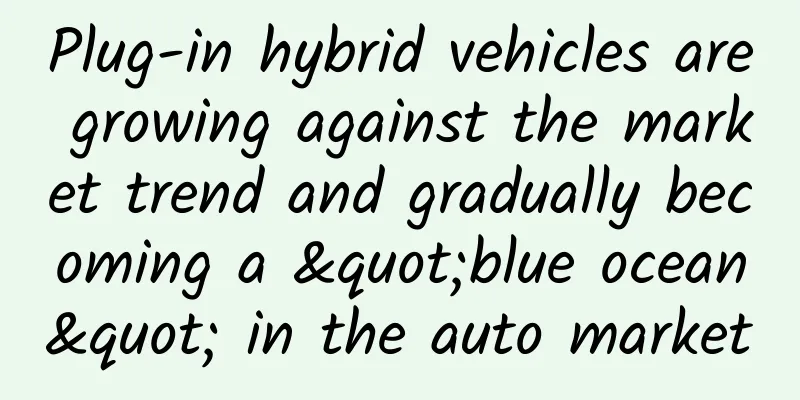Plug-in hybrid vehicles are growing against the market trend and gradually becoming a "blue ocean" in the auto market

|
Since the release of the "Automotive Industry Investment Management Regulations (Draft for Comments)" in May 2018, the debate on plug-in hybrids has never stopped, and the industry is particularly concerned about whether plug-in hybrids are classified as new energy vehicles. At the same time, with the continuous advancement of technology and the improvement of industrial chain capabilities, the number of plug-in hybrid models has gradually increased, and sales have risen accordingly. According to data from the China Passenger Car Association, from January to August this year, sales of new energy passenger vehicles reached 509,000 units, of which plug-in hybrid vehicles accounted for 28.35%. On a monthly basis, unlike the ups and downs in sales of pure electric vehicles, plug-in hybrid vehicles have maintained a steady upward momentum. Plug-in hybrid vehicle development is steadily increasing From the sales trend chart, the sales trends of pure electric passenger cars and plug-in hybrid passenger cars are obviously different. Pure electric vehicles show a trend of large fluctuations, and each fluctuation is affected by policies, while plug-in hybrid vehicles maintain a relatively stable trend, basically showing a steady upward trend. As the national new energy vehicle policies tend to favor pure electric vehicles, plug-in hybrid vehicles have been suppressed. In 2016, the sales of pure electric passenger vehicles reached 240,000 units, a year-on-year increase of 114.36%; the sales of plug-in hybrid passenger vehicles were 80,400 units, a year-on-year increase of only 26.4%. In 2017, the sales of pure electric passenger vehicles reached 448,800 units, a year-on-year increase of 86.9%; the sales of plug-in hybrid passenger vehicles reached 107,600 units, a year-on-year increase of 33.8%. Since 2018, the growth rate of plug-in hybrid passenger cars has gradually increased. From April this year, the year-on-year growth rates of pure electric passenger cars were 131.78%, 130.27%, 56.09%, 45.60% and 38.20%, respectively. The growth rate has gradually narrowed, while plug-in hybrid passenger cars have maintained a year-on-year growth rate of more than 100%, and the market has developed rapidly. Automakers are competing to launch plug-in hybrid models to seize the market The sales growth is closely related to the flourishing of related models. Driven by market demand and the double-credit policy, both domestic brands and mainstream joint venture brands have launched their own PHEV models in recent years. The plug-in hybrid models launched by BYD and SAIC, the leaders in the plug-in hybrid market, have always been recognized by consumers. In the sales ranking of new energy passenger cars in August, BYD Tang PHEV won the championship with 5,043 units. This is the second time that a plug-in hybrid model has won the sales championship of new energy passenger cars since BYD Song DM won the championship in February this year. As the new hybrid flagship model for the implementation of the "Blue Geely Action" strategy, the plug-in hybrid versions of Borui GE and BYD Tang launched in early April this year dominate the plug-in hybrid B-class car market, with sales in August also increasing by 65.54% month-on-month. On September 12 this year, Changan's first new plug-in hybrid SUV, the CS75 PHEV, was released in Shanghai. As a blockbuster product promoted by the "Shangri-La Plan", Changan Automobile hopes to leverage the popularity of the CS75 to boost its overall sales. Also at the end of August this year, Toyota revealed that it would cooperate with Geely Automobile to promote hybrid technology. One is a leading Chinese automobile brand, and the other is a world-renowned automobile company with its own core technology. The combination of the two companies may create a hybrid whirlwind in the new energy field. At the same time, joint venture brands such as Hyundai, Volvo, and Audi have also launched corresponding plug-in hybrid products. The new Ford Mondeo plug-in hybrid and the BMW 5 Series plug-in hybrid have both received good market response. There is still a lot of room for plug-in hybrid market Apart from policy factors, at the usage level, the pure electric range of most PHEV models on the market is about 50 to 70 kilometers, which meets the daily commuting needs. The comprehensive fuel consumption of the Ministry of Industry and Information Technology is generally between 2L and 3L. Of course, this value is only for reference in actual use, but due to the existence of traditional engines, pure electric and plug-in hybrid can effectively solve the "mileage worry" on the basis of fuel saving. Compared with mature automobile markets such as the United States and Europe, plug-in hybrid vehicles and pure electric vehicles are basically in a "equal position". Relevant data shows that in 2017, the sales ratio of pure electric vehicles to plug-in hybrid vehicles in Europe was about 1:1; while in the United States, plug-in hybrid vehicles accounted for about 47% of the total sales of new energy vehicles. As a supporter of PHEV, BYD Chairman Wang Chuanfu once publicly stated: "PHEV will be the mainstream of new energy private cars in the world. Under the current technical conditions and usage environment, PHEV is still the best transition technology path to achieve full electrification of automobiles. This judgment has been fully confirmed in many countries and regional markets around the world, including Europe and the United States." In China, as subsidies for new energy vehicles decline year by year, the price of pure electric vehicles is gradually losing its advantage. As China's new energy vehicle market gradually matures, the advantages of plug-in hybrid vehicles will further expand. Competition with HEVs Mentioning plug-in hybrid electric vehicles (PHEV) always reminds people of HEV (hybrid electric vehicle), which is only one letter different from PHEV. According to the data of China Passenger Car Association, from January to August 2018, 144,000 plug-in hybrid electric vehicles were sold, and 123,000 hybrid electric vehicles were sold. In terms of sales, plug-in hybrid electric vehicles are slightly ahead. Looking back at the market situation in the past three years, the sales of HEV were much less than PHEV in the early stage. With the inclination of local preferential policies, the sales of several HEV models have been boosted. At present, the two are moving forward in parallel. Regarding the future development of the two, Cui Dongshu, secretary general of the China Passenger Car Association, said that with the trend of plug-in hybrids, some domestic automakers that had previously deployed conventional hybrids have gradually stopped promoting conventional hybrids and turned to plug-in hybrids. And with the strong deterrent effect of the national dual-credit policy, the trend of ordinary hybrids turning into plug-in hybrids has become more obvious. Zhu Yulong, a columnist of No.1 Electric and a senior engineer of electrification, said: PHEV is defined as a new energy vehicle at the national level, and has certain advantages in policy resources. From the perspective of the natural development of the market, as more and more charging piles are reserved in parking spaces of residential infrastructure, charging piles will become a basic part of our lives, and will gradually increase the bargaining chips of PHEV. HEV and PHEV are like variants of a technical route. Judging from the current development trend of battery technology, it has a great driving effect on PHEV and is also very beneficial in the Chinese market. The construction and expansion of personal and public charging networks will also greatly enhance the competitiveness of PHEV. A typical example is Toyota. Toyota, the leader in the hybrid field, brought the plug-in hybrid models of Corolla and Levin to the Beijing Auto Show in April this year. In the 312th batch of "Announcement on Road Motor Vehicle Production Enterprises and Products" issued by the Ministry of Industry and Information Technology in the middle of this month, it can be seen that the Toyota Corolla plug-in hybrid has been put on the public display. Obviously, Toyota has begun to adjust its technical strategy to keep up with the market. According to a study by Simai Automotive Information Consulting, global sales of pure electric vehicles are expected to be less than 1 million by 2020, but sales of plug-in hybrid vehicles will reach 1.35 million and further increase to 2.7 million by 2025. It can be foreseen that plug-in hybrid vehicles will become a new "blue ocean" in the automotive market against the backdrop of the overall downturn in the Chinese auto market. As a winner of Toutiao's Qingyun Plan and Baijiahao's Bai+ Plan, the 2019 Baidu Digital Author of the Year, the Baijiahao's Most Popular Author in the Technology Field, the 2019 Sogou Technology and Culture Author, and the 2021 Baijiahao Quarterly Influential Creator, he has won many awards, including the 2013 Sohu Best Industry Media Person, the 2015 China New Media Entrepreneurship Competition Beijing Third Place, the 2015 Guangmang Experience Award, the 2015 China New Media Entrepreneurship Competition Finals Third Place, and the 2018 Baidu Dynamic Annual Powerful Celebrity. |
Recommend
How to do community operation? Positioning and user analysis are equally important!
Community operation is currently a popular operat...
Apple sells ads on the App Store, what does this mean?
How are Apple App Store’s default search ads made...
Taking League of Legends as an example: How does Tencent Games operate?
Tencent Games is one of Tencent's four major ...
Why do many people have a mole on the same position on their arms? In these 5 cases, go to the hospital as soon as possible!
Source: Dr. Curious...
Norovirus is entering its peak period! How to prevent it?
China Science and Technology News Network, Februa...
What are the number ranges for 400 telephone numbers?
When enterprises are handling 400 telephone numbe...
WeChat 8.0.15 for iOS officially released, adding 1 new feature and solving major problems
WeChat has released the official version V8.0.15 ...
A fireball appeared in Beijing! Can you pick up a meteorite?
In the early morning of March 27, a rare scene oc...
A complete event planning framework!
As an APP operator, you often need to plan activi...
MWC 2016: The story of mobile phones is no longer exciting, VR is becoming the new favorite of manufacturers
If we mark the technology events on the map in th...
The "involution" of the 618 content marketing war
This year's 618 is becoming more and more &qu...
Google releases Fuchsia specification for its non-Linux operating system
Google has revealed details of its non-Linux oper...
Analysis of Wugumofang's private domain operations
With the development of the Internet, private dom...
White rice has no nutrition? Cold rice has no calories? All the rice issues you care about are here →
Author: Xue Qingxin, registered dietitian Reviewe...









